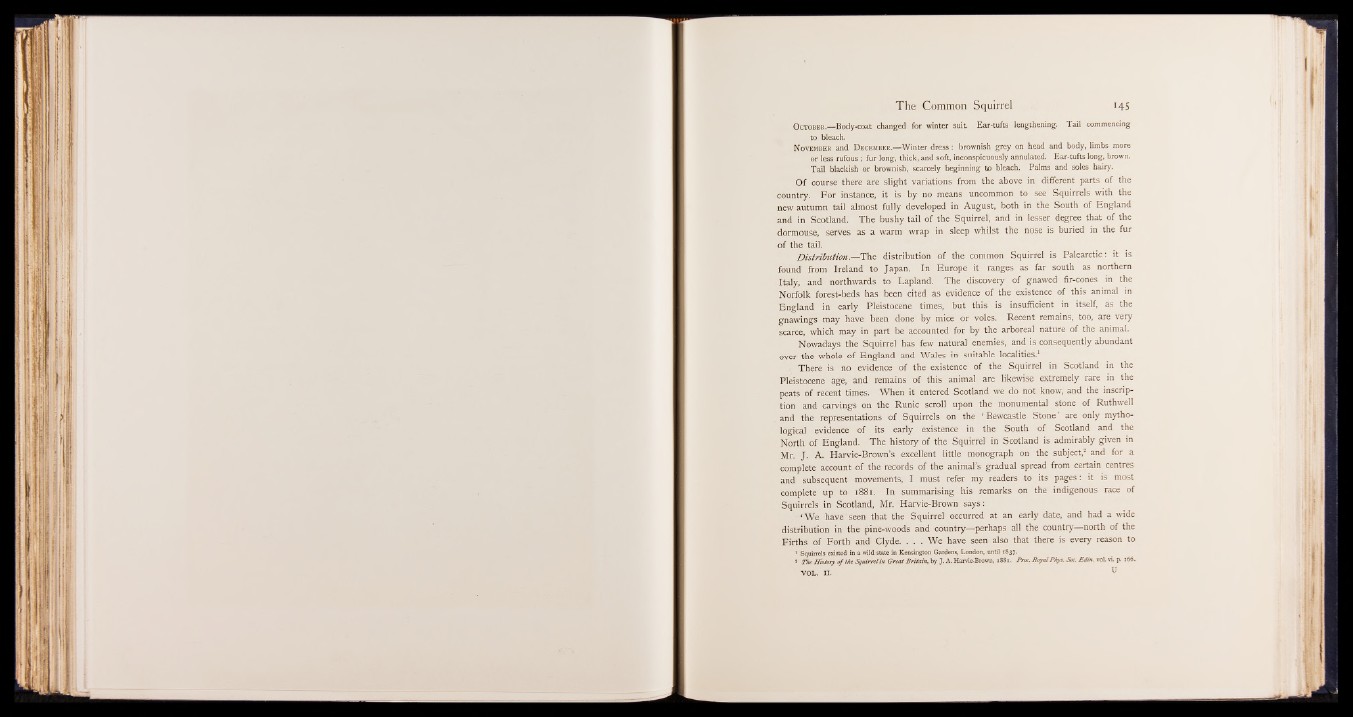
O ctober.—Body-coat changed for winter suit. Ear-tufts lengthening. Tail commencing
to bleach.
N ovember and D ec em b er .—Winter dress : brownish grey on head and body, limbs more
or less rufous ; fur long, thick, and soft, inconspicuously annulated. Ear-tufts long, brown.
Tail blackish or brownish, scarcely beginning to bleach. Palms and soles hairy.
Of course there are slight variations from the above in different parts of the
country. For instance, it is by no means uncommon to see Squirrels with the
new autumn tail almost fully developed in August, both in the South of England
and in Scotland. The bushy tail of the Squirrel, and in lesser degree that of the
dormouse, serves as a warm wrap in sleep whilst the nose is buried in the fur
of the tail.
D istribution.—The distribution of the common Squirrel is Palearctic: it is
found from Ireland to Japan. In Europe it ranges as far south as northern
Italy, and northwards to Lapland. The discovery of gnawed fir-cones in the
Norfolk forest-beds has been cited as evidence of the existence of this animal in
England in early Pleistocene times, but this is insufficient in itself, as the
gnawings may have been done by mice or voles. Recent remains, too, are very
scarce, which may in part be accounted for by the arboreal nature of the animal.
Nowadays the Squirrel has few natural enemies, and is consequently abundant
over the whole of England and Wales in suitable localities.1
There is no evidence of the existence of the Squirrel in Scotland in the
Pleistocene age, and remains of this animal are likewise extremely rare in the
peats of recent times. When it entered Scotland we do not know, and the inscription
and carvings on the Runic scroll upon the monumental stone of Ruthwell
and the representations of Squirrels on the ‘ Bewcastle Stone are only mythological
evidence of its early existence in the South of Scotland and the
North of England. The history of the Squirrel in Scotland is admirably given in
Mr. J . A. Harvie-Brown’s excellent little monograph on the subject,2 and for a
complete account of the records of the animal’s gradual spread from certain centres
and subsequent movements, I must refer my readers to its pages: it is most
complete up to 1881. In summarising his remarks on the indigenous race of
Squirrels in Scotland, Mr. Harvie-Brown says:
‘We have seen that the Squirrel occurred at an early date, and had a wide
distribution in the pine-woods and country—perhaps all the country—north of the
Firths of Forth and Clyde. . . . We have seen also that there is every reason to
1 Squirrels existed in a wild state in Kensington Gardens, London, until 1837.
2 The History o f the Squirrel in Great Britain, by J. A. Harvie-Brown, 1881. Proc. Royal Phys. Soc. Edin. vol. vi. p. 166.
VOL. II. U